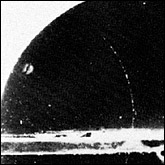Antimatter Discovery
 In almost every science fiction movie ever made, you are bound to hear about antimatter –– matter-antimatter propulsion drives, whole galaxies made of antimatter, and so on. Antimatter has been used in science fiction so much that some of us are not even sure if it is real or just imaginary. Here's a hint: antimatter is real and it was discovered a long time ago.
In almost every science fiction movie ever made, you are bound to hear about antimatter –– matter-antimatter propulsion drives, whole galaxies made of antimatter, and so on. Antimatter has been used in science fiction so much that some of us are not even sure if it is real or just imaginary. Here's a hint: antimatter is real and it was discovered a long time ago.
It all started with Paul Dirac, a British physicist, who in 1930 devised the first relativistic theory of the electron. Quantum mechanics had been worked out a couple of years earlier (by Dirac and by Heisenberg, independently), but Dirac’s 1930 theory contained math that exactly modeled electron behavior, both from the quantum mechanical and from the relativistic point of view (electrons moving at close to light speeds). His theory also predicted the existence of an anti-electron; a particle just like an electron, with the same mass but opposite charge (i.e. positive) and opposite magnetic momentum. If you fire such a particle into a magnetic field which is perpendicular to the particle’s trajectory, its path would curve opposite to that of an electron.
In 1932, Carl Anderson, a US physicist, while examining tracks of particles produced by cosmic rays, noticed one track whose curvature was identical to that of an electron but was flipped. Instead of curving to the right, it curved to the left. He named this positively charged electron a positron, the first antimatter particle discovered. Many anti-particles have been discovered since. The anti-proton was discovered in 1955 by E. Segre and his coworkers at the Lawrence Berkeley Laboratory using a high-energy particle accelerator. Most other anti-particles have been discovered at particle accelerators under carefully designed conditions. Many experimental groups have also reported constructing bigger entities than just anti-particles. In fact, whole anti-nuclei have been constructed, for example anti-hydrogen nuclei and an isotope of anti-helium.
About the Author
Anton Skorucak, MS
 Anton Skorucak is a founder and publisher of ScienceIQ.com. Anton Skorucak has a Master of Science (MS) degree in physics from the University of Southern California, Los Angeles, California and a B.Sc. in physics with a minor in material science from the McMaster University, Canada. He is the president and creator of PhysLink.com, a comprehensive physics and astronomy online education, research and reference web site.
Anton Skorucak is a founder and publisher of ScienceIQ.com. Anton Skorucak has a Master of Science (MS) degree in physics from the University of Southern California, Los Angeles, California and a B.Sc. in physics with a minor in material science from the McMaster University, Canada. He is the president and creator of PhysLink.com, a comprehensive physics and astronomy online education, research and reference web site.


